10 Reasons Japanese Mini Trucks Beat Regular UTVs
Here are the top 10 reasons to choose a Japanese mini truck as your off-road transport solution in the USA. Why settle for a regular UTV when Japanese mini trucks offer so much more?
Jump To Section
Since you’re here at Mini Truck Depot, it’s clear you have some knowledge about Japanese mini trucks—even if it’s just from taking a ride in one owned by a friend. But whether you’re completely new to kei trucks or have plenty of experience with them, these off-road UTVs offer more than meets the eye. Here are 10 solid reasons why you should seriously consider replacing that rough-riding UTV with a Japanese mini truck. And if any of these points resonate with you, be sure to check out the UTV-replacement mini trucks for sale right here on our site.
1. Japanese Mini Trucks Offer a More Comfortable Ride
Just because you need to go off-road to get work done around your ranch or farm doesn’t mean you have to sacrifice your comfort in the process. In fact, one of the top reasons people trade up from a UTV side-by-side to a mini truck is because they’re tired of being jolted around all day by the harsh suspension on regular UTVs like the Polaris RZR models. A UTV side-by-side might feel like a fun toy when you’re younger, but when it comes to getting serious work done—and doing it in comfort—a mini truck is by far the better choice.
First of all, just look at the difference in construction between them. As you can see below, the mini truck is built with a proper frame, featuring independent shocks all around on some models, or shocks in the front with leaf springs in the rear on others. In comparison, the steel tube sub-frame and elementary suspension found on a typical UTV look like something from another era.
Then there are the seats. If you’re after something sporty, the seating in some side-by-sides might fit the bill. But if you’re looking for a tool—not a toy—it’s the Japanese mini truck seats, with their adjustability and easy in-and-out access (something you do constantly when you’re out working on your property), that really make the difference.
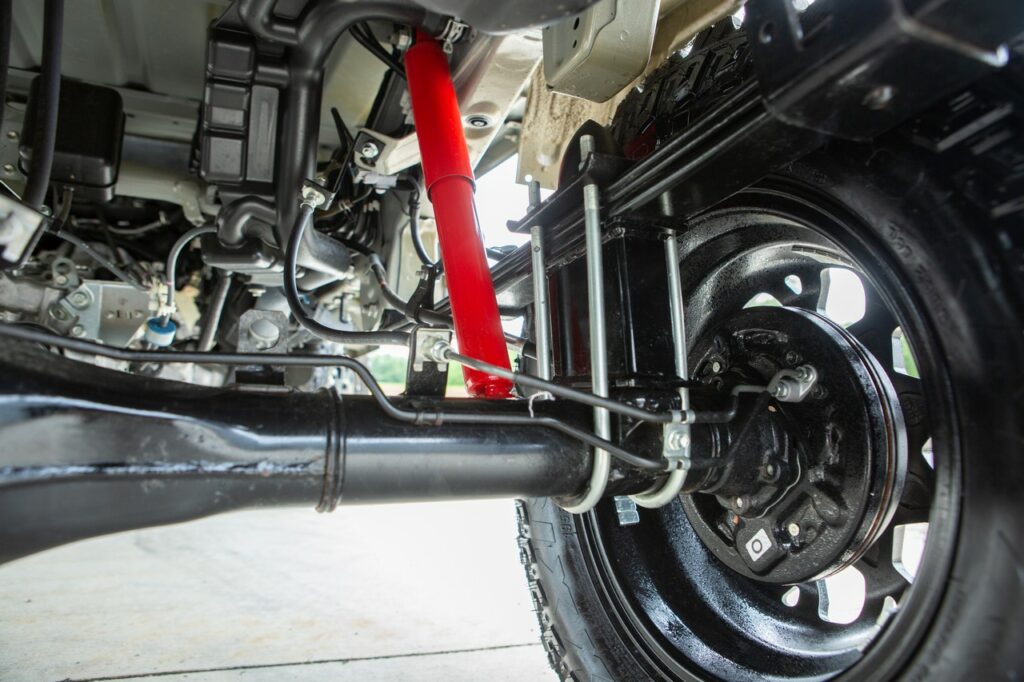
2. Mini Truck Comfort Goes Beyond the Ride
So when it comes to a mini truck, your back isn’t getting sore from being jolted around as it would in a traditional UTV, nor is it getting twisted in awkward ways every time you climb in and out. But having a good day out in the fields isn’t just about avoiding injuries. When it’s cold, you want to stay warm. When it’s blazing hot, you want a cool refuge. After all, this is a place you spend countless hours of your working life.
Now, Japanese mini trucks, like the popular Daihatsu Hijets we sell, don’t just have fully weatherproof cabs with properly rubber-sealed doors—they also come with AC and heat as standard. That’s right, no need to mess around adding essentials like AC (or even doors!) as optional extras like you often have to when buying a regular UTV. As you’d expect from mini trucks built in a country where summer highs soar past 100 degrees and winter lows drop well below freezing, the AC and heating systems in mini trucks are more than capable of handling both the desert heat of Arizona and the harsh winter snow of Minnesota.
Plus there are the little touches that just make life better—the practical details you’re used to but would be hard-pressed to find in a typical side-by-side. Sun getting low in the evening? Pull down a sun visor to keep the glare out. Bringing some piping hot coffee along on a cold, dark morning? Set it securely in a convenient cup holder. It’s these kinds of details that make a mini truck a much more comfortable, welcoming environment.

3. What About Real Off-Road Skills?
More than comfort, this is a key point: Do mini trucks have what it takes when it comes to that crucial question: ‘Can it really go off-road? I mean, really into the wild?’ It’s a fair question. After all, Japanese mini trucks aren’t just designed for farmers and ranchers. What about hunters and other outdoor enthusiasts who need a UTV they can rely on when heading deep into remote wilderness? Whether it’s rugged trails, steep inclines, or unpredictable terrain, you need to know that what you’re driving is built to handle it all without hesitation.
Firstly, wherever you’re headed, having confidence in its power is key. You don’t want something that struggles on a gentle hill or feels underpowered when it matters most. That’s where the mini truck shines. Its 660cc engine is larger than most UTV engines, delivering nearly twice the power. But having power isn’t enough if the UTV is weighed down by unnecessary bulk. That’s not a problem here. With an average weight of around 1,400 lbs, a typical mini truck is right at the low end of the UTV weight spectrum—considerably lighter than models like a 1,775 lb Kubota. More power, less weight. That’s what gives you performance.
Now, how does that power get to the wheels? First off, every Japanese mini truck you’ll see here at Mini Truck Depot is equipped with a 4×4 powertrain. And, while UTVs are often limited to CVT or VHT (Variable Hydro Transmission) options, mini trucks offer a much wider range of choices. There’s the standard 5-speed manual transmission, a 5-speed manual with switchable hi/lo range, 3-speed automatics, and even CVT options. Add in a locking rear differential on some manual transmission models and on newer CVT Daihatsu Hijets, and it’s easy to imagine how these mini trucks are more than capable of handling tough climbs, uneven terrain, and demanding off-road conditions.
4. Mini Trucks Tow & Haul Too
So, for off-road comfort and performance, these Japanese mini trucks deliver. But beyond that, the real question is—can they handle the workload? Moving feed, hay bales, fence posts, tools, and equipment isn’t just an occasional task; it’s part of daily life on a ranch or farm. Now, these mini trucks have been described as tools, not toys, but do they truly have the capability to haul and tow effectively?
Again, the answer is clear. First of all, take a look at the bed on this Daihatsu Hijet. It’s not just spacious—it’s built for practical hauling. Measuring 6 feet 8 inches in length, it offers significantly more room than any standard UTV bed, providing the capacity needed to handle all sorts of sizes and shapes of load.
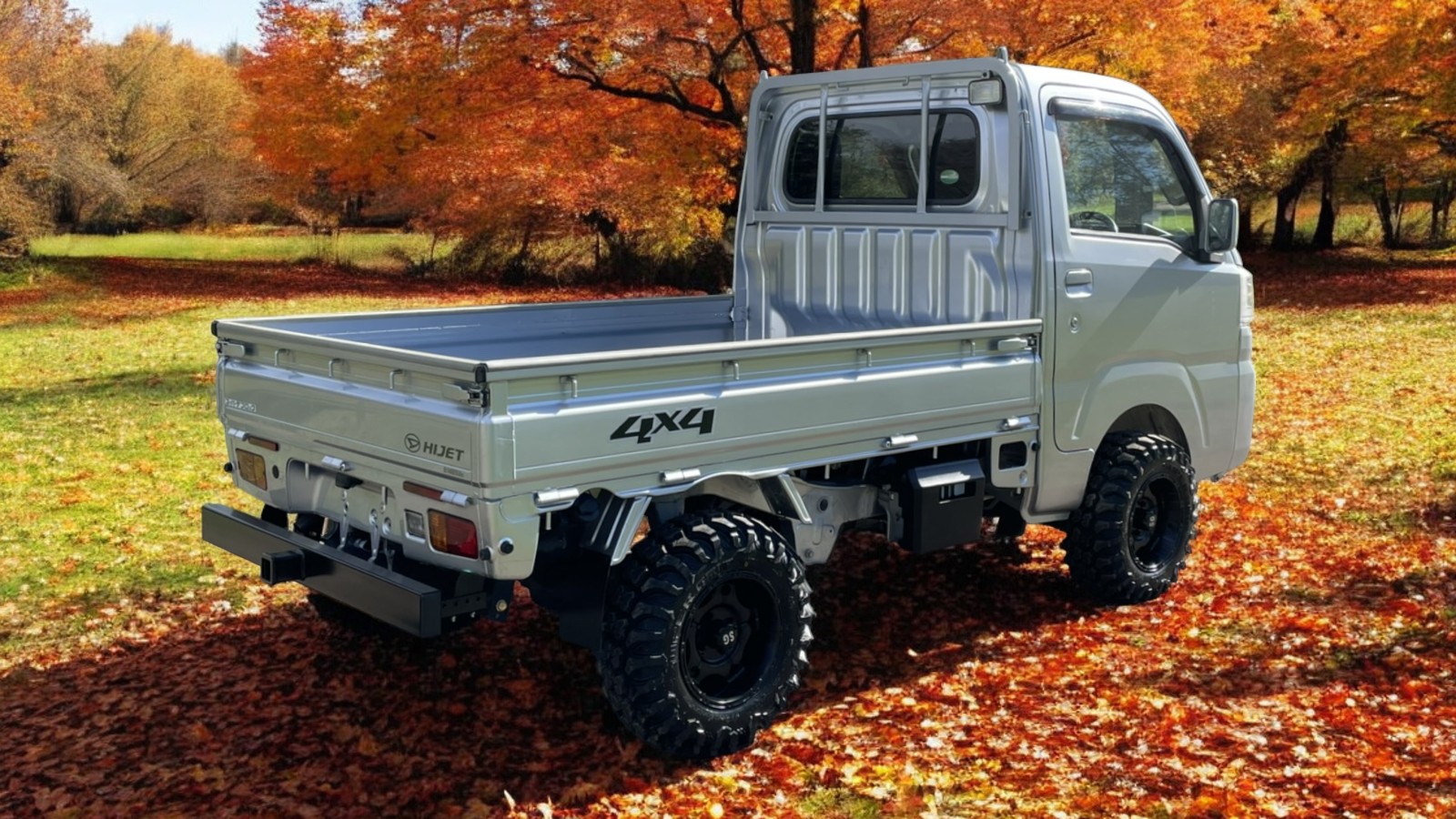
Now, take a look at one of its standout features—not just a clever addition, but a really practical design element that helps reduce strain on your back when loading and unloading throughout the day:
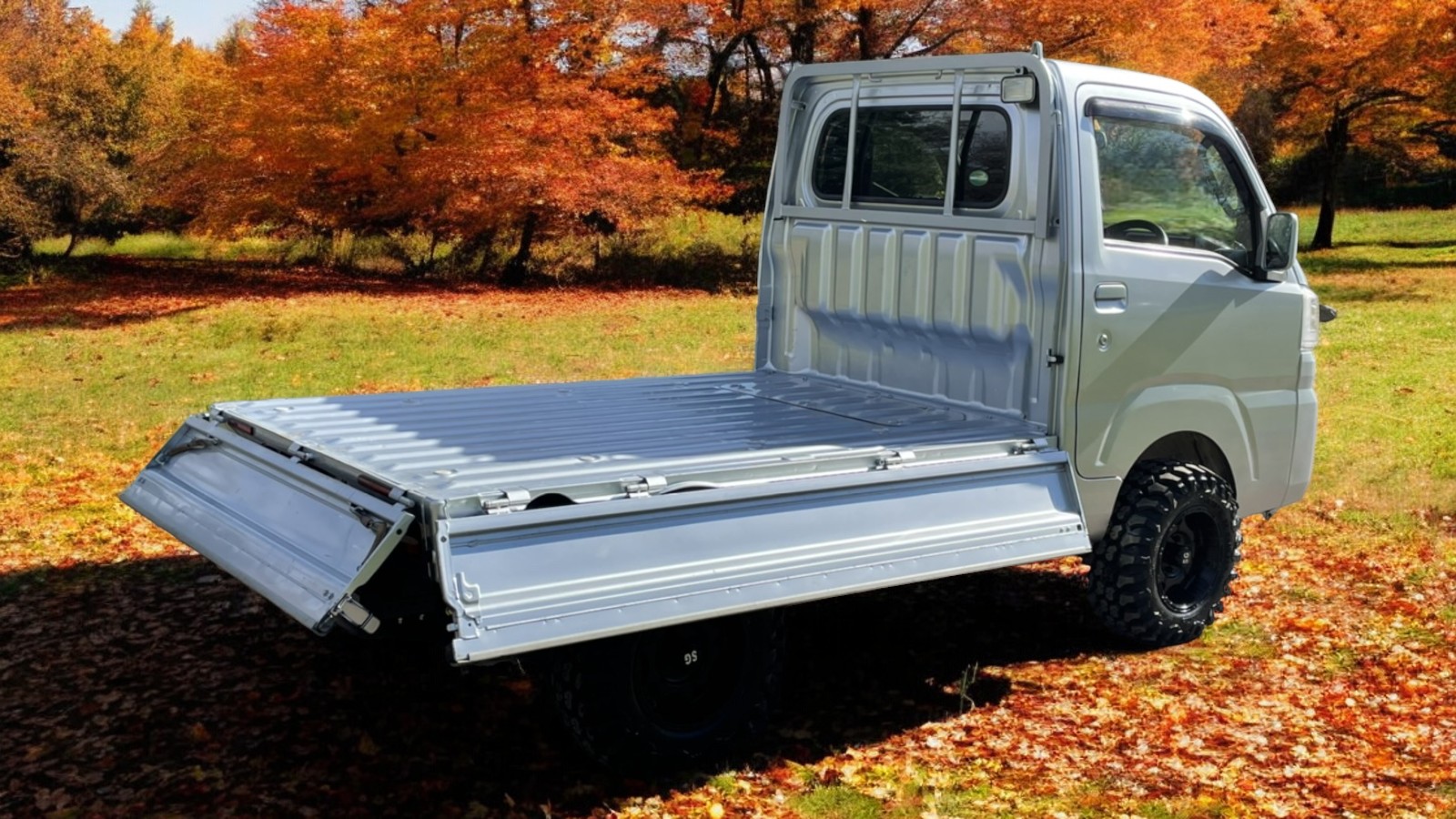
Notice that? The sides fold down, and there’s no lip to get in the way when loading or unloading. You can drop all three sides at once, or just lower the one you need. No more stretching or reaching over the bed—simply drop the side and grab whatever you need with ease.
Once everything’s loaded, it’s time to get moving. Settle into the cab, AC running to keep you cool, coffee in the cupholder, radio playing. Turn the key, engage the gear, and—will it haul?
The engine roars to life. The transmission engages. And off it goes without hesitation. That’s no surprise when a more powerful engine than what’s found in most UTVs is paired with a lightweight frame as found in these mini trucks. In fact, you can load up to around 1,500 lbs in some models, and these hardworking mini trucks will handle it with ease. Compared to most work UTVs, which max out between 1,300 and 1,500 lbs, mini trucks offer a clear advantage.
When it comes to towing, you get the same great performance. Equipped with an (optional) Reese 2-inch receiver hitch at the rear, the mini truck can tow around 1,500 lbs—right at the upper limits of what UTVs can manage. Of course, it’s not designed to tow 1,500 lbs while also hauling a 1,500 lb load simultaneously. These mini trucks are tough, but even they have their limits.
5. Can Mini Trucks Dump?
Something else you’ll love about Japanese mini trucks is the variety of configurations available. While we’ll cover more of these later, let’s focus on the dump mini trucks for now. Sure, a fixed bed is useful, but a dump bed adds even more versatility. Even among the dump models, there are different types of dumps and bed designs—including the rare and sought-after scissor lift dump, which we’ll get to shortly.
Starting with dump beds, there’s the standard bed, similar to what you’d find on regular cab models, but with a dumping mechanism added. This called is the Light Duty (LD) Dump. Then there’s the HD Dump—short for Heavy Duty—model which features thicker steel, reinforced construction, and added protection at the front of the box to prevent material from shifting onto the rear of the cab. What’s great about these is that both LD and HD dump beds retain the three-way opening functionality of fixed beds you saw above, making regular loading and unloading just as easy—plus the added benefit of dumping capability.
When it comes to tipping the load, these Japanese mini trucks offer a couple of options. There’s no one-size-fits-all approach here. You can choose between an electro-hydraulic mechanism or a PTO (Power Take-Off) system to power the dump bed. Each has its strengths. For maximum power, the PTO is the go-to choice. For greater flexibility, the electro-hydraulic system stands out. What does flexibility mean in this case? Unlike the PTO, the electro-hydraulic dump can be operated while driving. This is ideal for tasks like spreading feed in the field—just load it up, drive slowly, and gradually raise the bed as you go. On the other hand, if you’re hauling heavy materials like gravel all day, the PTO system is likely the best tool for the job.
Now, for the part you’ve been waiting for—the scissor lift dump. This particular mini truck is extremely rare, but here’s what makes it unique: it doesn’t just dump. It can also raise the bed horizontally using a scissor lift mechanism. Here’s how it looks in action:
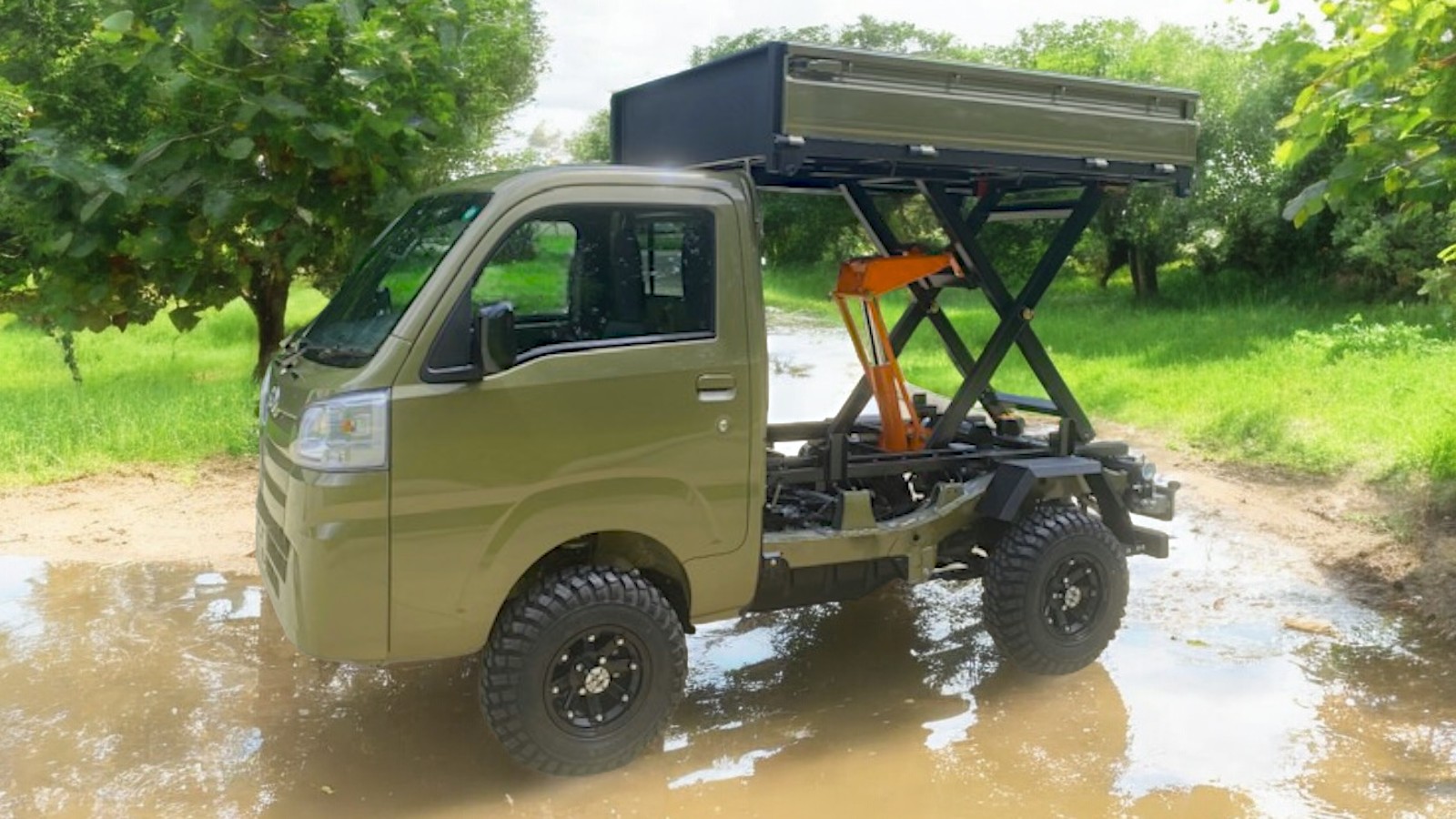
6. Mini Trucks Are Real Off-Roaders
Japan has a mountainous spine running the length of the country, so off-road work mini trucks like these have to be built to handle snowy inclines and rough forest tracks. Anything less simply wouldn’t be up to the task. The manual models, equipped with hi/lo range and locking rear differentials, as well as the CVT models with locking rear differentials, are especially well-suited to these demanding environments.
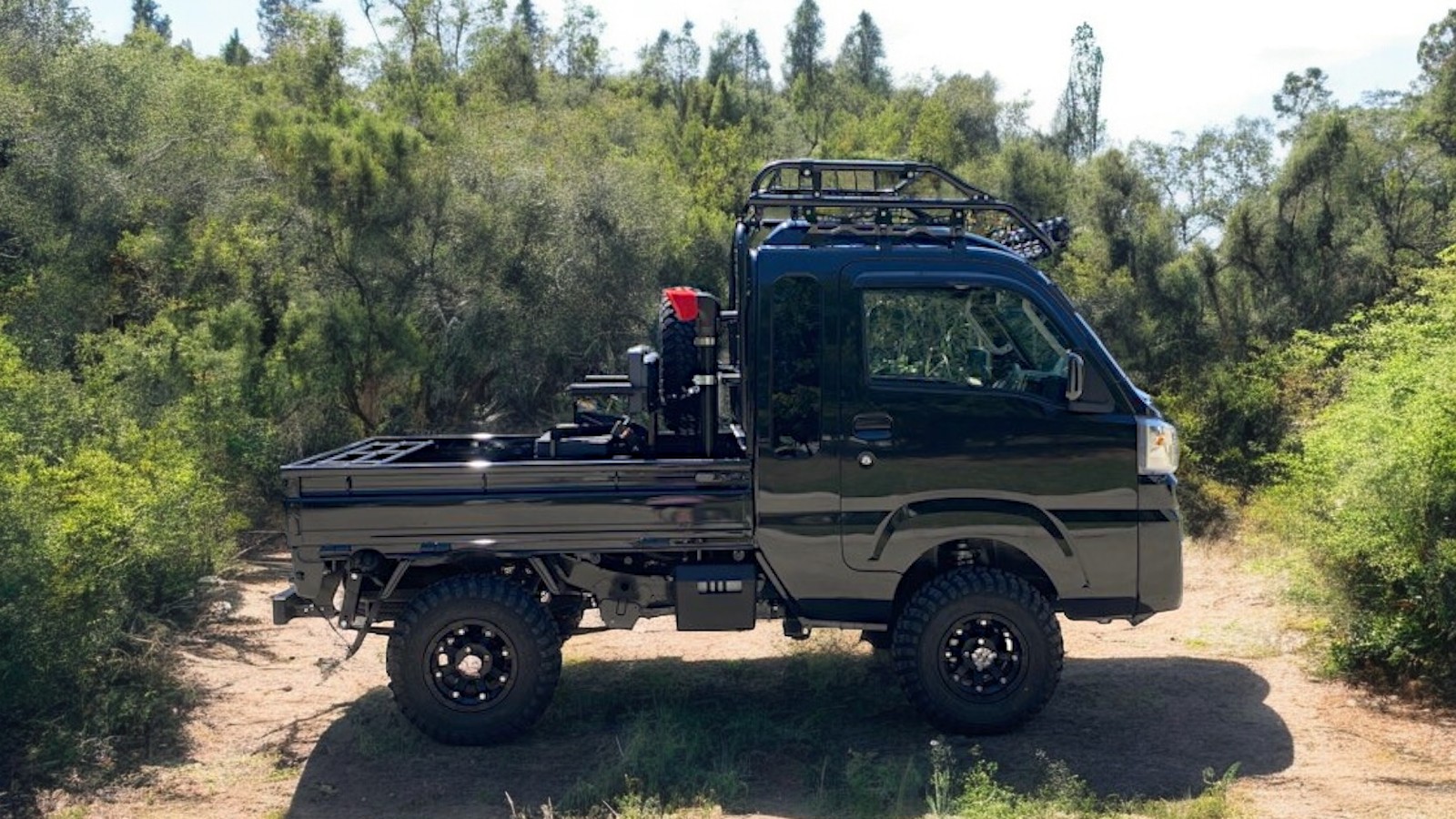
Thanks to their lightweight design and knobby tires, these mini trucks rarely get bogged down. They also offer impressive ground clearance—more than a regular UTV—while featuring a low-mounted engine that provides a lower center of gravity. This combination results in excellent stability, making it hard to imagine a better design for taking you just about anywhere.
And speaking of a lower center of gravity, that brings us to the next reason to choose a Japanese mini truck—safety.
7. Japanese Mini Trucks Are Safe
That lower center of gravity we just mentioned? It’s not only great for off-road stability but also plays a key role in safety. It’s not just about handling steep ravines or rugged inclines—when driving off-road around your property, a lower center of gravity significantly reduces the risk of tipping over, helping to prevent potential injuries.
But mini truck safety goes beyond just avoiding rollovers. Consider this: how many regular UTVs come with a full steel shell to protect the passengers? When you have to pay extra just to add windows and doors on a typical UTV, it’s clear that occupant protection isn’t always a top priority. With a Japanese mini truck, the steel shell is standard, providing built-in protection without the need for additional gear like helmets, which are often required when driving many side-by-sides.
8. Japanese Mini Trucks Have So Many Body Styles
Traditional UTVs tend to stick to a familiar, well-established pattern when it comes to body styles. That’s not the case with Japanese mini trucks. Let’s take a closer look at the options available when buying a mini truck. Since most modern mini trucks are either Daihatsu Hijets, Suzuki Carrys, or rebadged versions of these models for other manufacturers, we’ll focus on these two brands.
First up are the regular cab mini trucks—and take a look at that striking metallic orange paint job!
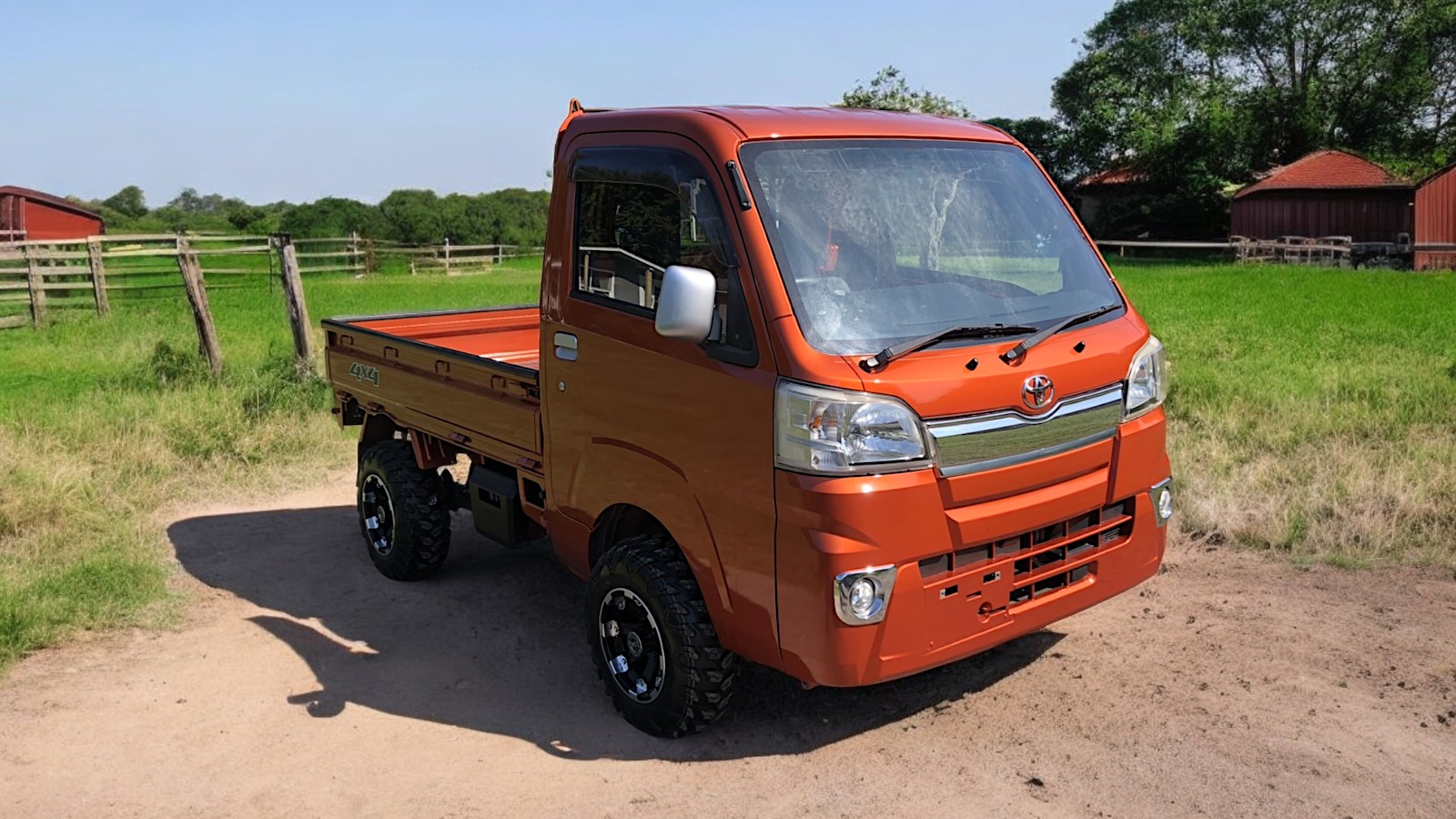
Then there are models with larger cabs. The Daihatsu Hijet version is called the Hijet Jumbo, while Suzuki’s is known as the Super Carry. The Hijet Jumbo is more popular in the US and is often considered to have a more refined design, which is why you’ll find them featured here at Mini Truck Depot.
You’ve already seen a couple of Daihatsu Hijet Jumbos further up the page, but here’s a clear side view of a silver one. This angle highlights the additional space at the rear of the cab, offering a noticeable difference compared to the orange regular cab model shown above.
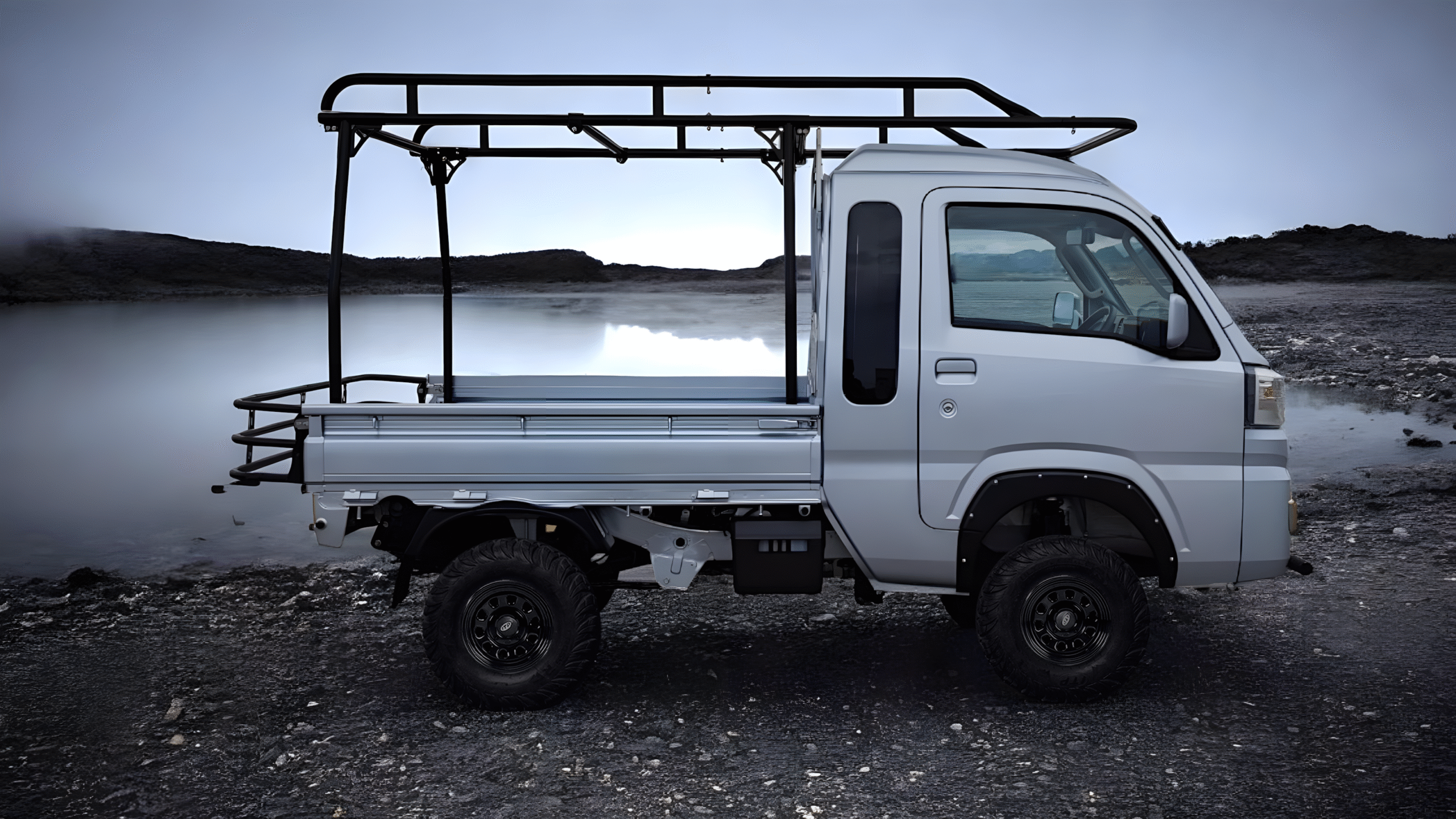
Japanese mini trucks are available in other configurations as well. If the goal is to move both people and cargo, these next body types offer great alternatives. Each is designed to carry four passengers off-road, providing both comfort and safety.
First, let’s take a look at the Deckvan. As shown here, it’s a crew cab-style design with a practical, deep rear bed along with easily accessible rear seats. Here’s a view of that spacious rear load area—notice how the gate folds down smoothly for easy access.

Now imagine how easy it is to bring kids, grandkids, or even your dogs along for off-road trips around the farm, thanks to the wide-opening sliding rear doors that make climbing on board effortless.
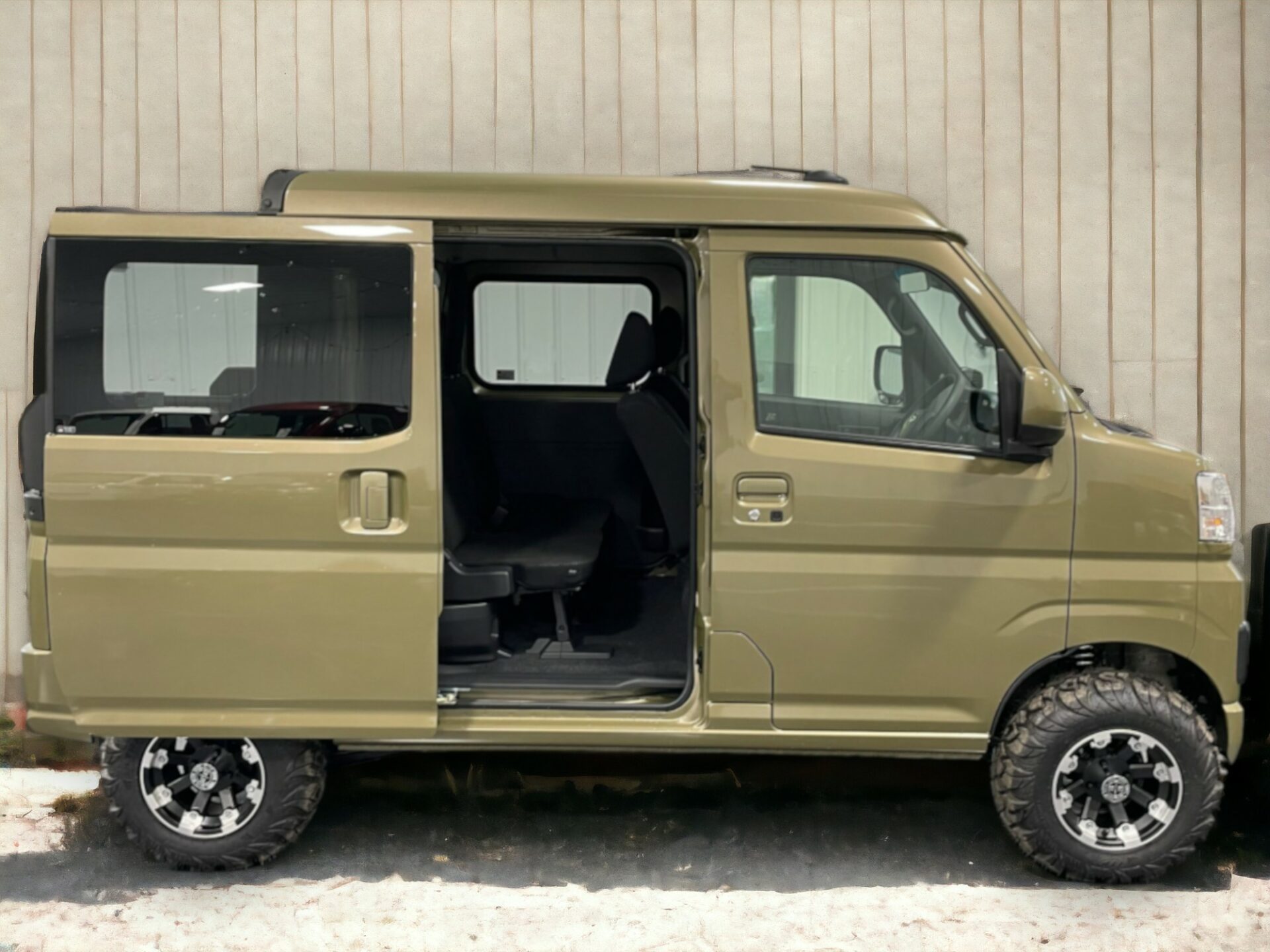
The Deckvan is an extremely versatile off-road Japanese mini truck, with that combination of an open load bed and an enclosed cab. But if you need something for environments like a college campus or hospital complex, where you need to move both people and equipment out of the elements, then a fully enclosed rear load area might make more sense. In that case, the van-style body of the Daihatsu Hijet Cargo is the perfect fit. Take a look at the impressive amount of space available with the seats folded down:
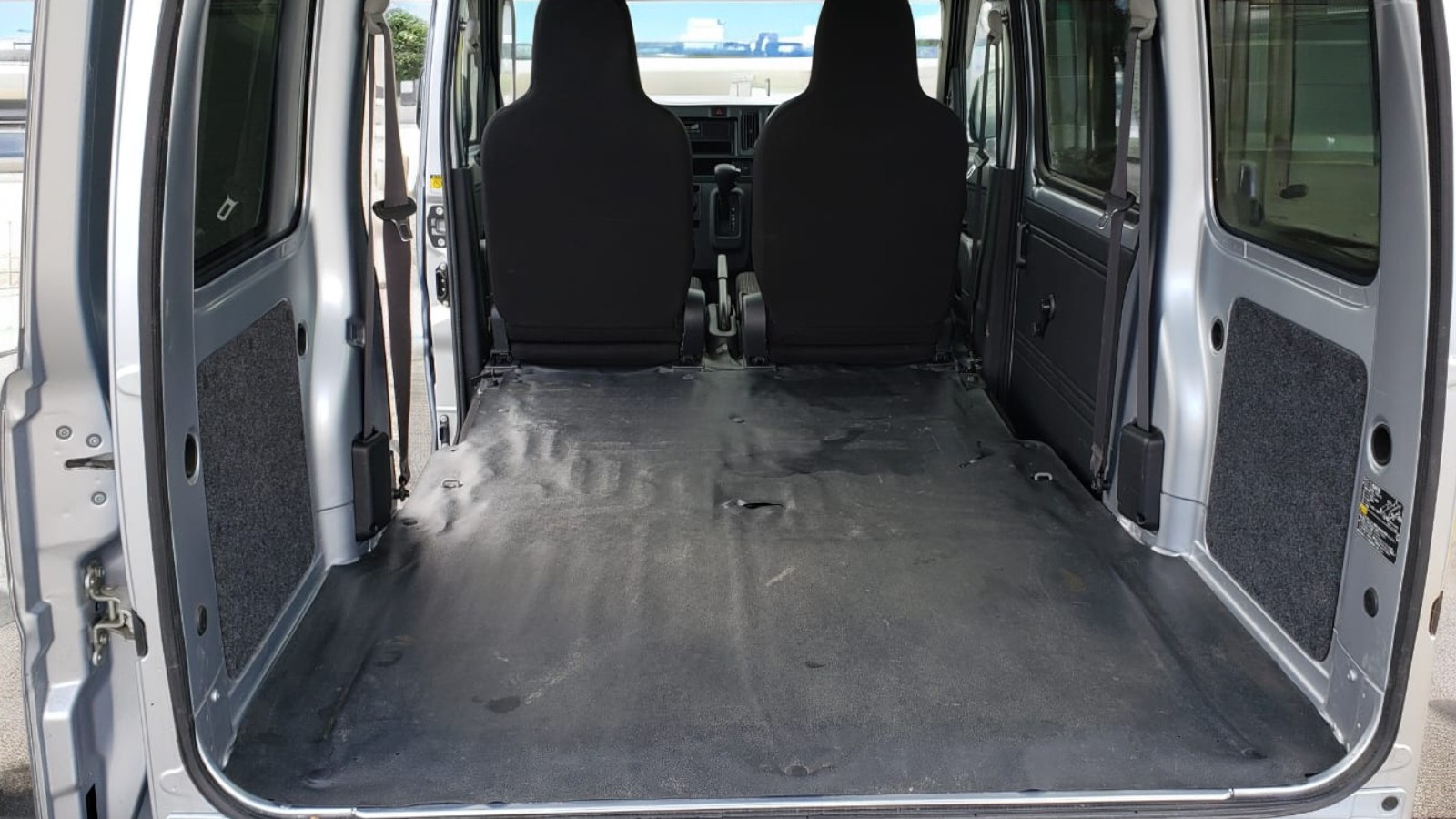
No matter the job that needs doing, or if you’re looking for an off-road solution that combines comfort with true off-road capability for hunting or off-grid adventuring, there’s at least one model and body style that’s sure to meet your needs—possibly even more.
And if you’re not sure which option is the right fit for you?Read this page here, or get in touch, and we’ll help you find the best choice for your specific requirements.
9. Japanese Mini Trucks Sip Fuel
Think gas prices are high? In Japan, they’re about 60% higher. That’s tough news for people in Japan, but surprisingly, it’s great news for you. How so? Well, when fuel prices are that high, nobody wants to waste a drop of gas. If you’re a farmer working out in rural areas, driving around your fields all day to get things done, the last thing you want is for your fuel bill to be one of your biggest monthly expenses.
Japanese mini truck manufacturers understand this reality. They know that the farmers and workers buying these mini trucks in Japan don’t have the luxury of wasting extra Yen on fuel either. That’s exactly why these mini trucks are engineered to be exceptionally fuel-efficient. And with each new generation, they keep getting better. Take the 11th generation Daihatsu Hijet, for example, launched at the end of 2021. In CVT form, it achieves 25% better fuel economy than the previous model. Not that the 10th generation was inefficient by any means. In fact, the 10th generation model can easily achieve 35 to 40 MPG in typical off-road use, which is impressive for an off-road UTV of its capability.
So, how does that compare with other off-road options? Let’s put the mini truck head-to-head with a typical UTV side-by-side. What kind of mileage does a standard UTV get? About 20 MPG. That’s significantly worse than the mini truck. Those numbers aren’t just a small difference—they’re miles apart, and that gap translates directly into cost savings when you buy a min truck. Over time, those savings really add up, making a noticeable impact on your bottom line. If you’re driving your mini truck around the farm every day, you could be saving hundreds, if not thousands, of dollars per year on fuel costs alone.
So, if you’re looking for an off-road solution that can handle tough jobs while saving you a lot of money on gas, the Japanese mini truck has no real competition.
10. Japanese Mini Trucks Make You Mr. / Ms. Popular
You’ll be surprised by how much attention these Japanese mini trucks attract— and it’s the good kind. Friends will ‘just happen’ to stop by, even if it means going 20 miles out of their way, hoping to catch a ride in your mini truck. ‘Let me take it for a spin!’ they’ll say. What might seem like just a new workhorse for the farm from your perspective will seem like something out of this world to everyone else.
In a world where UTVs are often seen as the default choice, discovering that there’s a better alternative can be a real eye-opener. If you hadn’t read this here on Mini Truck Depot, you might have been caught off guard by all the attention and curiosity your mini truck will generate once it arrives.
How long will the novelty last? It’s hard to say. Hardcore UTV enthusiasts will likely stick with what they know. But sooner or later, some of those friends who come to check out your mini truck will want one for themselves. (When they do, send them here so we can help them out, too.) Over time, mini trucks are bound to become more common. But for now, you can enjoy being ahead of the curve, soaking up the friendly curiosity that comes with owning a Japanese mini truck—one with at least 10 solid reasons as to why it’s the best off-road UTV alternative you can buy in America.
You’ve made it this far. What do you think? Ready to get one? Take a look at the Japanese mini trucks for sale right now.
Not Sure Which Mini TruckTo Pick?
Convinced there are at least 10 solid reasons why Japanese mini trucks outperform the alternatives? Great. But if you’re not ready to buy just yet because you’re unsure which model will best suit your needs, don’t worry—the answer is right here. This quick guide will help you choose the best Japanese mini truck for you.

